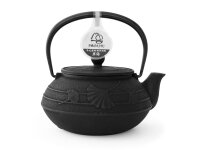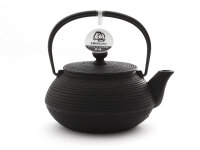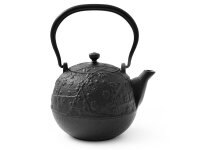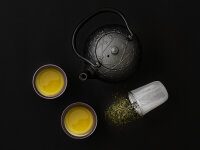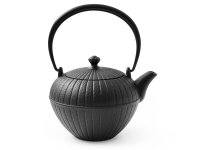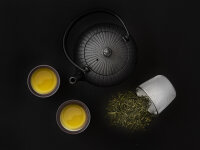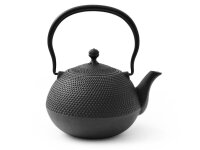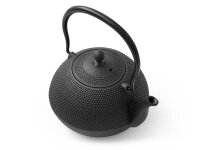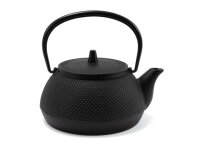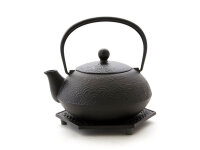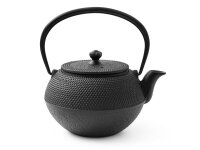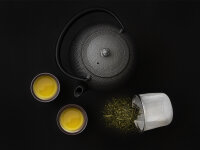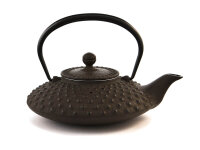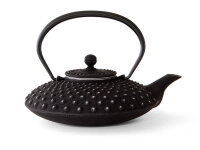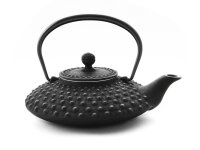
Teapot Cast Iron
Cast Iron Teapots. Beware of Confusion!
Those looking to buy a teapot face a tough decision. Countless shapes, designs, and various materials are available. In Asia, especially in Japan, cast iron teapots with stainless steel infusers rank high on the list. In the West, they are mainly considered by those who have delved deeper into the enjoyment of tea, beyond traditional Western methods. The way tea is enjoyed varies greatly around the world. Cast iron teapots are naturally adapted to the customs and traditions of Asia – China, Japan, India, Taiwan, etc. They are usually small, often holding less than a liter, as most tea enthusiasts in Japan prefer to drink smaller, freshly brewed quantities. Japanese teapots with infusers are ideal for this purpose.
We see risks in purchasing, especially in two aspects:
- Mistaking it for a cast iron water kettle, Tetsubin
- Quality differences
On many websites, the Japanese teapot made of cast iron is also called Tetsubin. According to our research, including in Japan, this is not entirely accurate. The Tetsubin is a cast iron water kettle used solely for heating water, often in accordance with tradition, for brewing tea. The traditional Tetsubin in Japan is not coated on the inside; high-quality products are only given a protective coating of Urushi lacquer—a natural tree resin lacquer—that inhibits rust formation and seals the cast iron. In contrast, the teapot made of cast iron is coated on the inside with enamel. While its tradition is also quite old, it is notably younger than that of the Tetsubin. Those who heat water on the stove in a Japanese cast iron teapot with enamel risk damaging the enamel. There are a few cast iron Japanese teapots that are actually suitable for both heating water and brewing tea—known as combination models. Iwachu, the market leader, currently offers such a model, which is uncoated on the inside. You can find it in our selection.
Another matter entirely is the risk of confusing the quality. The highest-quality products are crafted by hand using elaborate methods and consist of pure natural materials. These can be identified by the manufacturer's trademarks and the indication of the country of origin. These Japanese teapots, therefore, come at a price. Unfortunately, as is often the case, there are many imitators who offer both Tetsubin and cast iron teapots at sometimes low to cheap prices. Caution is advised here. Inferior craftsmanship is certainly frustrating, but it is not necessarily dangerous. However, poor-quality material, potentially contaminated with harmful substances, could endanger health. One should be very cautious with bargains, especially when they are claimed to be Japanese products, as the few companies that manufacture these products in Japan do not produce mass quantities and cannot afford to market products at low prices.
When and Why Is the Cast Iron Teapot the Right Choice?
What should one consider when buying the right teapot for themselves? Let's assume that the goals are quite similar: the tea you want to drink should taste as good as possible. The teapot you want to use should be visually appealing. Here, personal taste naturally plays the primary role. Not everyone likes an Arare pattern. And the teapot should, in terms of its use, at least satisfy or, even better, bring joy. In our opinion, the ideal teapot also has a long lifespan, is virtually indestructible, can even be passed down through generations, and enhances the taste experience and the health of tea drinkers.
The Design. Or the Question: Is a Cast Iron Teapot Beautiful?
We all know that there are more or less objective criteria for judging design. However, we dare to claim that most people have a pretty good sense of whether a product—and indeed a cast iron teapot—looks good. Our advice, therefore, is to listen to or, even better, pay attention to your feelings. Most motifs or designs on cast iron teapots are classic. The most famous is the Arare pattern (Hailstone pattern), which is ancient and still very popular not only in Japan. Most often, the pots are black, but there are also more and more available in different colors.
The fact that these Japanese teapots are often copied by manufacturers from other countries and offered at cheaper to more affordable prices is a clear indication to a Japanese person that the designs are well-received. They view it—as a way not to get upset—as a compliment. Usually, you can spot the difference between a handmade Arare pattern and a cheap copy upon closer inspection. The few manufacturers in Japan that produce high-quality cast iron teapots know, anyway, that the quality of their products is unattainable if someone does not master the technique and wants to produce very inexpensively. But back to the topic: Is an Arare teapot beautiful? - ask your heart, and if it sparks, an error is hardly possible. And if you fall in love with a Kyusu made of Tokoname clay from Japan, go for it. A Japanese teapot from Tokoname also offers genuine quality in all important aspects.
Which Tea with Which Teapot?
Naturally, the choice of the right teapot is also related to the type of tea you want to enjoy. There are many recommendations for this decision, and some very "sustainable" beliefs about which teapot should be used for which tea can be found, but there are probably no real "laws." However, some fundamental considerations, such as whether a Japanese cast iron teapot, one made of porcelain, clay, or glass, is the right choice, can help point you in the right direction. Let's distinguish first between non-flavored delicate teas, non-flavored robust teas, and flavored teas. And in terms of teapots, between those with a closed or nearly closed surface on the inside and teapots with rather open-pore surfaces. Finally, there's one very important point: Do you want to use a teapot that can enhance the taste, which may occur over time?
Neutral and Rather Neutral Teapots:
- Glass teapot
- Porcelain teapot. White or other colors
- Cast iron teapot, enameled. Black or other colors
- Clay teapot, fired very densely or even glazed. Black, brick-colored. Often adorned with various colors
These teapots do not significantly influence the taste of tea unless a patina has formed or it has been regularly removed.
Teapots Tending to Influence Taste:
- Clay teapot, reduction-fired, unglazed. Tends to be neutralizing, dampening acidity and bitterness. Suitable for all types of green tea. These teapots are usually purple to black.
- Clay teapot, oxidation-fired, unglazed. Tends to enhance the taste. Recommended for Sencha, Shincha, as well as Gyokuro, Kabusecha, etc.
- Cast iron teapots without enamel. Black or other colors
- Cast iron teapots with enamel and patina. Black or other colors
- Clay teapot with patina. Brick, black, or colored
Up to this point, the matter is relatively simple. Do you want to prepare lighter, delicate teas in neutral or flavor-influencing teapots, or vice versa? We have heard and read both recommendations and believe it depends. If you want to prepare a wide variety of different teas in a single teapot, we recommend a neutral teapot. For example, a Japanese cast iron teapot, a glazed clay pot, porcelain, or even glass. Although we - admittedly - are not fans of glass. Japanese green tea is usually enjoyed from a Japanese cast iron teapot or a clay teapot. However, if the range of tea types and their characteristics is narrower, or if someone is willing to acquire several teapots for different teas, teapots from the other group can offer significantly more taste experiences. We recommend trying it out, starting with one teapot and testing which teas work particularly well in it. However, these should be teas with similar characteristics, or else the teapots will need to be cleaned. Green tea is, by the way, a good cleaning agent. You will find it makes for a lot of fun, and you will discover some teas all over again. In our opinion, open-pore teapots should be used more for enhancing lighter, delicate teas. But there are other opinions on this matter as well.
The Advantages of the Cast Iron Teapot
When we think about preparing fine tea, most people envision boiling water in a stainless steel kettle and pouring it into a glass or porcelain teapot. Only a few tea drinkers think of the traditional Japanese method of brewing tea, using a water kettle and a cast iron or ceramic teapot.
Water kettles made of cast iron have been used in Japan for hundreds of years for tea preparation. This tradition has persisted in both the tea ceremony and everyday life. However, cast iron teapots have not been around for quite as long, mainly because using an uncoated teapot is not as straightforward. Cast iron teapots with enamel coating have only become more common recently.
The advantages of cast iron water kettles are primarily even heating, good heat retention, and the release of minerals and iron, which results in an enrichment of the water, highly appreciated by many. Cast iron teapots offer similar advantages: they do not cool down nearly as quickly as glass teapots, meaning the teapot keeps the tea warm for up to an hour after brewing, with the temperature remaining almost constant during the brewing time. So, for connoisseurs who take their time, teapots with infusers are ideal. Remove the infuser after the correct time, enjoy the tea leisurely, put the infuser back in, and prepare the next infusion.
The Japanese cast iron teapot enriches the tea as well, though not as strongly as an uncoated Tetsubin. The durability of a cast iron teapot is exceptionally high because, like all high-quality cast iron products, a cast iron teapot can provide joy for a lifetime and beyond. Many tea enthusiasts claim that with proper use, the tea from these teapots only gets better, making this argument not only sensible for environmental reasons. In Japan, there are families that have been using their Tetsubin and cast iron teapots for many generations.
There is also accessories available for Japanese cast iron teapots. Although not much is needed to enjoy tea with such a pot. A cast iron coaster is stylistically certainly the right choice. No accessories are required for cleaning; a bit of green tea—brewed—will suffice to easily remove any stains if necessary. One accessory highly valued in Japan is an incense burner, such as our Sakura by Iwachu. A good scent is the best companion for a tea drinker.

